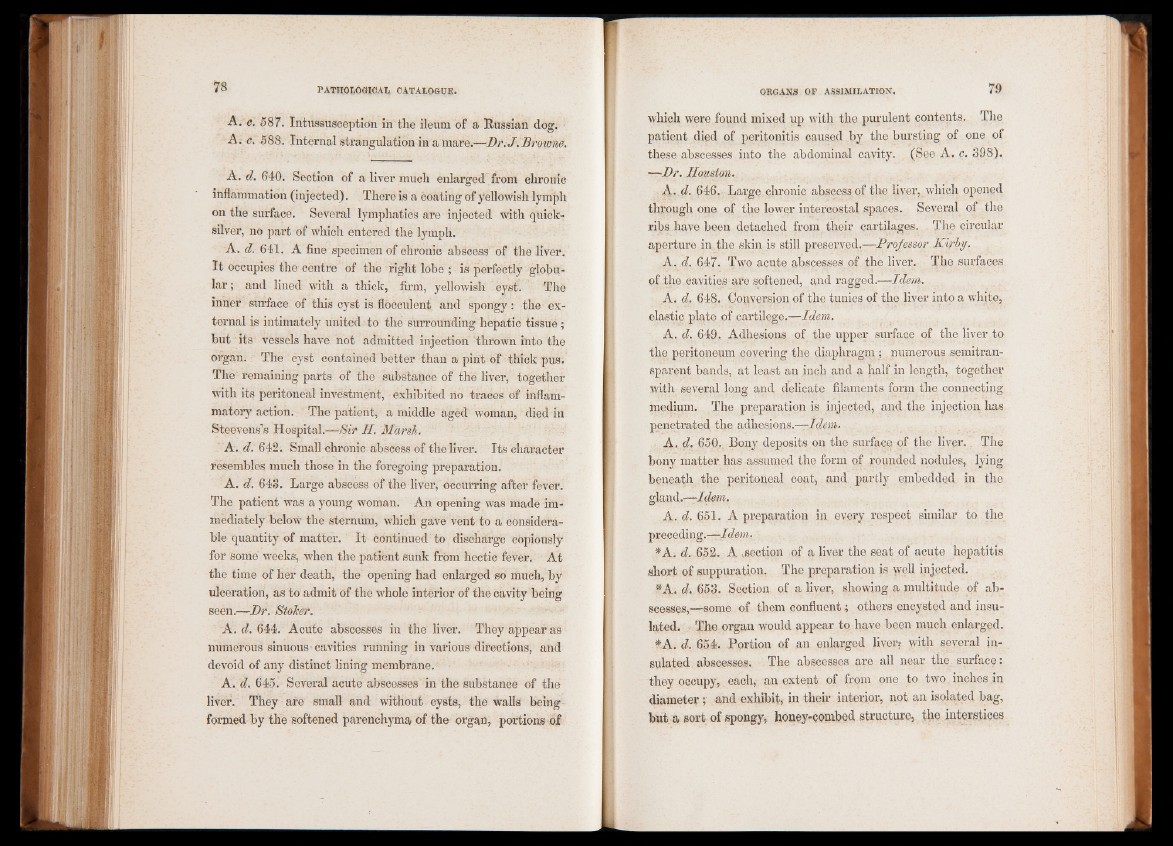
A. e. 587. Intussusception in the ileum of a Russian dog.
A. c. 588. Internal strangulation in a mare.—Dr. J.Browne.
A. d. 640. Section of a liver much enlarged from ehronic
inflammation (injected). There is a coating of yellowish lymph
on the surface. Several lymphatics are injected with quicksilver,
no part of which entered the lymph.
A. d. 641. A fine specimen of chronic abscess of the liver.
It occupies the centre of the right lobe ; is perfectly globular
; and lined with a thick, firm, yellowish cyst. The
inner surface'of this cyst is flocculent and spongy: the external
is intimately united to the surrounding hepatic tissue;
but its vessels have not admitted injection thrown into the
organ. The cyst contained better than a pint of thick pus.
The remaining parts of the substance of the liver, together
with its peritoneal investment, exhibited no traces of inflammatory
action. The patient, a middle aged woman, died in
Steevens’s Hospital.—-Sir II. Marsh.
A. d. 642. Small chronic abscess of the liver. Its character
resembles .much' those in the foregoing preparation.
A. d. 648. Large abscess of the liver, occurring after fever.
The patient was a young woman. An opening was made immediately
below the sternum, which gave vent to a considerable
quantity of matter. It continued to discharge copiously
for some weeks, when the patient sunk from hectic fever. At
the time of her death, the opening had enlarged so much, by
ulceration, as to admit of the whole interior of the cavity being
seen.—Dr. Stoker.
A. d. 644. Acute abscesses in the liver. They appear as
numerous sinuous cavities running in various directions, and
devoid of any distinct lining membrane.
A. d. 645. Several acute abscesses in the substance of the
liver. They are small and without cysts, the walls being
formed by the softened parenchyma of the organ, portions of
which were found mixed up with the purulent contents. The
patient died of peritonitis caused by the bursting of one of
these abscesses into the abdominal cavity. (See A. c. 398).
—Dr. Houston.
A. d. 646. Large chronic abscess of the liver, which opened
through one of the lower intercostal spaces. Several of the
ribs have been detached from their cartilages. The circular
aperture in the skin is still preserved.—Professor Kirby.
A. d. 647. Two acute abscesses of the liver. The surfaces
of the cavities are softened, and ragged.—Idem.
A. d. 648. Conversion of the tunics of the liver into a white,
elastic plate of cartilege.—Idem.
A, d. 649, Adhesions of the upper surface of the liver to
the peritoneum covering the diaphragm ; numerous semitransparent
bands, at least an inch and a half in length, together
with several long and delicate filaments form the connecting
medium. The preparation is injected, and the injection has
penetrated the adhesions.—-Idem.
A. d. 650.. Bony deposits on the surface of the liver. The
bony matter has assumed the form of rounded nodules, lying
beneath the peritoneal coat, and partly embedded in the
gland,—Idem.
A. d. 651. A preparation in every respect similar to the
preceding.—Idem.
*A. d. 652. A »section of a liver the seat of acute hepatitis
short of suppuration. The preparation is well injected.
*A. d. 653. Section of a liver, showing a multitude of abscesses,—
some of them confluent; others encysted and insulated.
The organ would appear to have been much enlarged.
*A. d. 654. Portion of an enlarged liver; with several insulated
abscesses. The abscesses are all near the surface:
they occupy, each, an extent of from one to two inches in
diameter; and exhibit, in their interior, not an isolated bag,
but a sort of spongy, honey-combed structure, the interstices